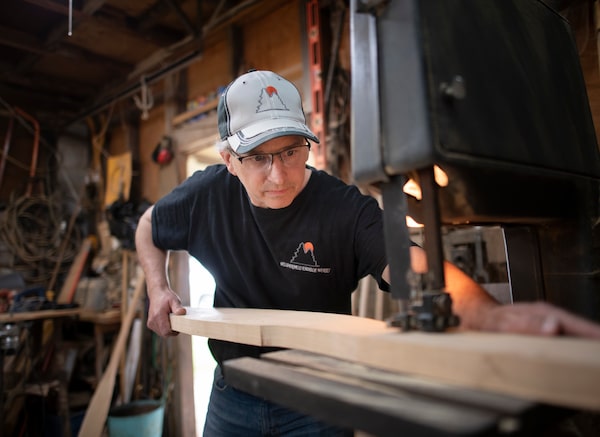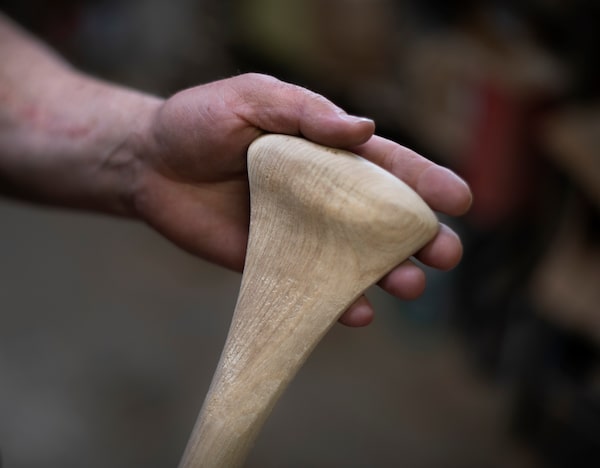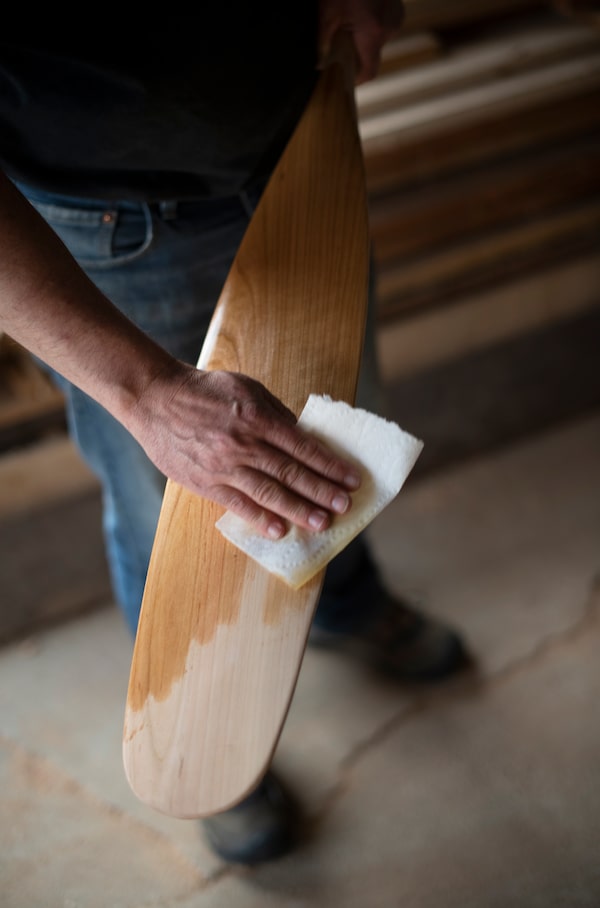
Mike Kipp examines some of the canoe paddles he made in his Princeton, Ont., workshop on May 16.Photography by Fred Lum/The Globe and Mail
Mike Kipp had a simple reason for starting to make his own canoe tripping paddles.
“I just wanted a better paddle,” says the 54-year-old founder of Wilderness Paddle Works.
A machinist at a small custom shop in Ayr, Ont., Mr. Kipp had always loved woodworking and canoe trips. The paddles he makes at his workshop outside his home in Princeton, Ont., are the natural result of those twin passions.

Mr. Kipp uses a bandsaw to cut the rough shape of a canoe paddle from a cherry paddle blank.Fred Lum/The Globe and Mail
But when he made his first paddle two decades ago, it wasn’t for himself. It was for his wife. Then he made one just for him. Next, he made paddles for his kids. The more he made for family and friends, the more word spread.
Outdoors enthusiasts are always looking for new gear, and a beautiful paddle stroking through the water or tipped against a tree at a campsite will always grab the eye. Soon enough Mr. Kipp was making paddles for Ontario’s Ministry of Natural Resources, which handed them out as gifts to long-time employees and volunteers of the province’s stewardship program.


No two of his paddles are alike; each bear different grains of wood and, especially with cherry, darken with age.
Mr. Kipp makes custom paddles ordered through his own company’s Facebook page and, as of two years ago, has been the sole supplier of paddles for the Canadian Outdoor Equipment Co., a store in Mississauga, where they sell for $186.50 each (custom-made paddles range in price).
He declined to discuss annual sales, saying only that he is “definitely a small-scale paddle maker,” although orders have increased “a fair amount” thanks to the exposure he’s gotten from his relationship with the Mississauga retailer.
No two of his paddles are alike because of the different grains of wood and, especially with cherry, how it will darken over time.
“You never know what you’re gonna get,” Mr. Kipp says “Every one is a one-off and you never know what the grain looks like. You can make three different paddles out of three different boards and they all look different.”
Each one, made from a single piece of ash or cherry, takes between six and seven hours to make. The wood is sourced from a sawmill near Mr. Kipp’s workshop. He planes them to the proper thickness, draws the shape of the paddle in pencil and then cuts them out with a bandsaw. From there, he planes them to their final shape before layering several coats of varnish on the blade and oiling the grip and handle.
It’s this process that makes Mr. Kipp’s paddles ideal for canoeing, says Tim Foley, owner of the Canadian Outdoor Equipment Co.
:format(jpeg)/cloudfront-us-east-1.images.arcpublishing.com/tgam/7GKSQER3IBARNFZYDL3XHBK6JE.jpg)
:format(jpeg)/cloudfront-us-east-1.images.arcpublishing.com/tgam/CHMETMZQWJC6FLD5MF3EM6SMLA.jpg)
:format(jpeg)/cloudfront-us-east-1.images.arcpublishing.com/tgam/J53KVNEMI5EC5IGQBXFL6T4CLI.jpg)
The shafts are slightly oval, not perfectly round, allowing you to get a sense of the direction of the paddle from feel as opposed to having to look at it, Mr. Foley says. As well, the handles are broader than the typical paddle, which gives more surface control.
Perhaps the best feature of the paddles, Mr. Kipp says, is that the oiled handle and shaft prevent blistering, unlike just a varnished handle.

Mr. Kipp uses a mix of tung and linseed oil to bring out the pattern of a cherry canoe paddle.
“That’s huge, especially if you’re doing longer trips where you’re paddling for two, three, four or five hours a day. You’re using that thing a lot during a trip,” Mr. Foley says. “So if it’s more efficient and more comfortable and you’re not getting hot spots or blistering, the more comfortable it is and the more distance you can get. And the less you’re fatigued at the end of the day.”
Mr. Kipp frequently gets requests for custom-made paddles that feature personalized elements, whether it’s the logo of a favourite sports team or a person’s initials. He uses a wood burner to create most of the designs. For more precise work, paddles can be laser engraved.
As beautiful as the paddles are, and no matter how personalized, Mr. Kipp wants them to be used, not displayed.
“I don’t believe in making too many wall hangers,” he says.

Mr. Kipp uses a wood burner to create most of the designs seen on the blades. For more precise work, paddles can be laser engraved.
And as popular as his paddles are, Mr. Kipp has no plans to scale up.
“You’d lose the personal aspect of it,” he says. “Mine are made start to finish by me and nobody else.”
 Dave McGinn
Dave McGinn